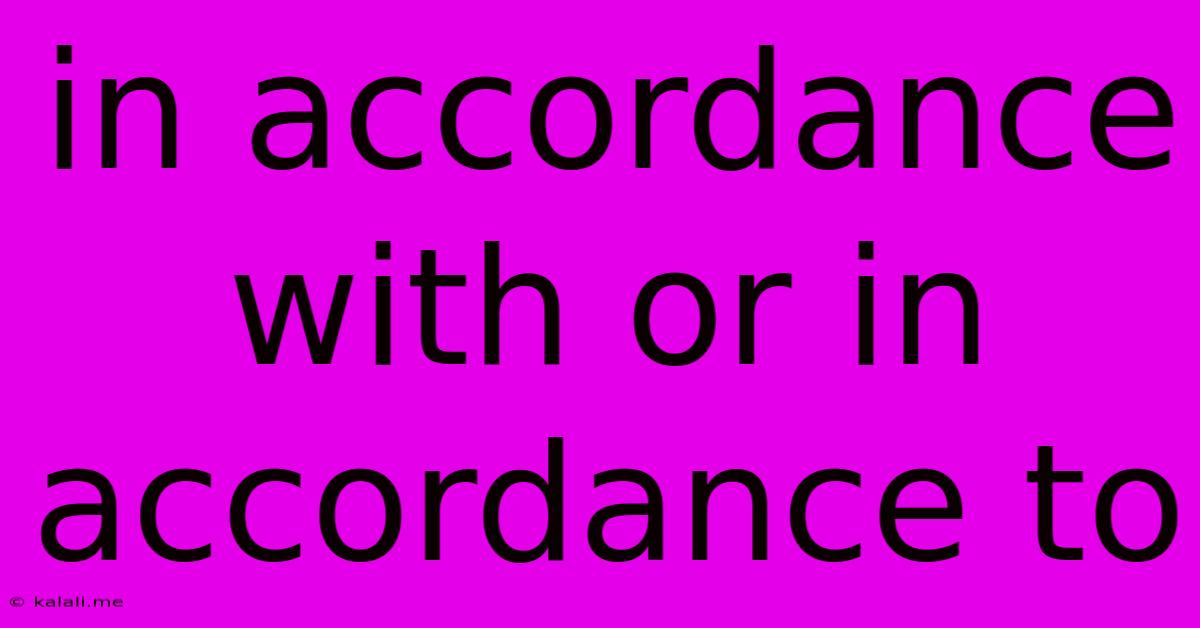In Accordance With Or In Accordance To
Kalali
Jun 05, 2025 · 2 min read

Table of Contents
In Accordance With vs. In Accordance To: Understanding the Subtle Difference
Choosing between "in accordance with" and "in accordance to" can feel like navigating a minefield of grammar. While both phrases aim to express conformity or agreement, there's a subtle yet significant distinction that impacts the precision and professionalism of your writing. This article will clarify the difference, helping you choose the correct phrase in any context. Understanding this nuance will elevate your writing and ensure your message is clear and accurate.
What's the difference? The short answer is: "in accordance with" is the grammatically correct and preferred phrase in almost all situations. "In accordance to" is generally considered non-standard and should be avoided.
Why "in accordance with" is preferred:
The preposition "with" is more logically consistent when discussing agreement or conformity. We say something is "in accordance with a set of rules," "in accordance with the law," or "in accordance with best practices." The preposition "with" indicates the object or standard to which something conforms. Think of it as aligning with something.
When to use "in accordance with":
- Following rules, regulations, or guidelines: "The project was completed in accordance with the client's specifications."
- Meeting standards or requirements: "All employees must conduct themselves in accordance with the company's code of conduct."
- Confirming compliance: "The product was manufactured in accordance with industry safety standards."
- Adhering to instructions: "The instructions should be followed in accordance with the manual."
Why "in accordance to" is generally incorrect:
The preposition "to" suggests a direction or destination. While it might seem semantically similar in some contexts, it lacks the clear implication of conformity or alignment that "with" provides. Using "to" implies a movement towards something, not a state of alignment.
Examples illustrating the difference:
-
Correct: "The report was written in accordance with the established guidelines." (The report aligns with the guidelines.)
-
Incorrect: "The report was written in accordance to the established guidelines." (The report's movement towards the guidelines is not the intended meaning.)
-
Correct: "The decision was made in accordance with the board's recommendations." (The decision conforms to the recommendations.)
-
Incorrect: "The decision was made in accordance to the board's recommendations." (Again, implying movement, not conformity.)
In summary: While you might encounter "in accordance to" in less formal writing, consistently using "in accordance with" demonstrates a superior grasp of English grammar and ensures your writing is clear, concise, and professional. This subtle distinction can significantly improve the credibility and impact of your communication. Stick to the correct and widely accepted phrase: in accordance with.
Latest Posts
Latest Posts
-
How To Keep Spices From Clumping
Jun 07, 2025
-
What Was In The Arc Of The Covenant
Jun 07, 2025
-
Can I Manually Closer Ac Damper
Jun 07, 2025
-
Did You Hear About The Magic Tractor
Jun 07, 2025
-
How Do You Catch A Tame Rabbit
Jun 07, 2025
Related Post
Thank you for visiting our website which covers about In Accordance With Or In Accordance To . We hope the information provided has been useful to you. Feel free to contact us if you have any questions or need further assistance. See you next time and don't miss to bookmark.